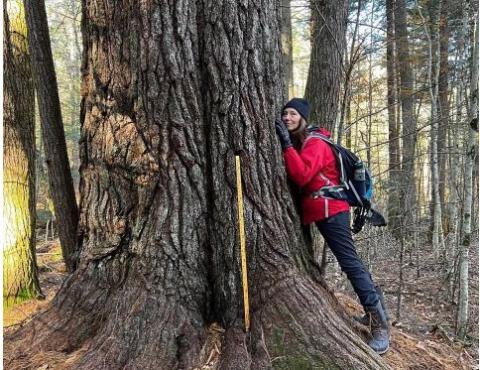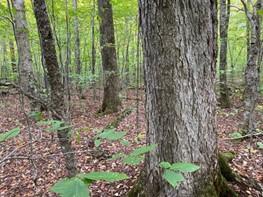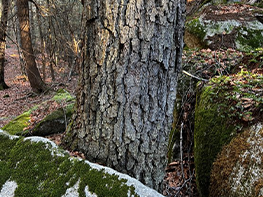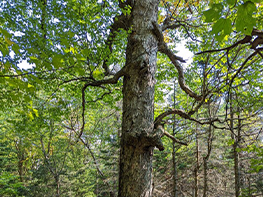Visit and explore some of New Hampshire’s finest examples of old-growth forests on Thursday, Sept. 21 and Saturday, Sept. 23. All trips will be led by experienced field researchers, forest ecology experts and natural resources professionals, many of whom are presenters at the conference.
All trips have limited space, and advance registration required. Sign-ups will be available in September. Carpooling is strongly encouraged.
|
Date & Time |
Old-Growth Forest |
Location |
Difficulty Rating |
Walk Length |
|
Thursday, 9:00am – 12:00pm |
Moultonborough, NH |
Moderate. Off-trail. 500’ elevation gain. |
2 miles |
|
|
Thursday, 9:00am – 12:00pm |
Franconia, NH |
Moderate. Off-trail. 400' elevation gain. |
1 mile |
|
|
Thursday, 9:00am-12:00pm |
N. Woodstock, NH |
Moderate. Some off-trail. Many steps. |
1 mile |
|
|
Thursday, 9:00am-12:00pm |
Ossipee, NH |
Easy |
2 miles |
|
|
Friday, 6:30am – 8:00am |
Geneva Point Conference Center |
Easy |
1 mile |
|
|
Saturday, 10:45am – 2:00pm |
Tamworth, NH |
Moderate. 600’ elevation gain. |
2.2 miles |
|
|
Saturday, 11:30am – 3:00pm |
Hart’s Location, |
Easy. Flat terrain. |
2 miles |
|
|
Saturday, 6:30am – 8:00am |
Geneva Point Conference Center |
Easy |
1 mile |
|
|
Saturday, 12:00 - 4:00pm |
Warner, NH |
Moderate. 850’ elevation gain. |
2 miles |
|
|
Saturday, 12:30pm – 4:30pm |
Hinsdale, NH |
Moderate. 850’ elevation gain. |
4 miles |
|
|
Saturday, 12:00pm – 4:00pm |
Newbury, NH |
Moderate. 1000’ elevation gain. |
3 miles |
|
|
Saturday, 11:00am – 5:00pm |
Tamworth, NH |
Moderate. 1000’ elevation gain. |
5 miles |

Admiring the champion Eastern White Pine tree in The Big Pines Natural Area.
Big Pines Natural Area at Hemenway State Forest in Tamworth. A Moderate 2.2-mile hike along trails with an elevation change of 600 feet. This 170-acre white pine–hemlock forest type has huge trees, including one white pine over 150 feet tall. The group will hike to a forest fire lookout tower overlooking the natural area with great views of the White Mountains. Bob Leverett, a legendary old growth forest researcher will be along on the hike to discuss carbon storage in one of the big pines. The Big Pines Natural Area is being added to the Old Growth Forest Network as part of the conference. Field trip leaders will be Christine Tappan from Birch Forest Walking and Sarah RobbGrieco the Northeast Regional Director of the Old Growth Forest Network. This will be the destination of two trips on Saturday. Trip offered Saturday.
More info: Towering Trees in Tamworth’s Big Pines Natural Area.
Castle in the Clouds in Moultonborough. A moderate two-mile walk mostly off-trail. The recently discovered old-growth forest has a history of only a few owners that kept the forest protected over the past two centuries. The forest is a northern hardwood-oak type with several uncommon plants growing in the understory. Situated on the remnants of an ancient volcano, the site has signs of a fire history in places, and the combination of enriched bedrock and dry conditions supports an unusual assemblage of species. Ecologist Rick van de Poll has studied and mapped the old growth forest here and will be our trip leader. Trip offered Thursday.
More info: Hiking at Castle in the Clouds Conservation Area.

The Dry River area is a classic example of a northern hardwood old-growth forest.
Dry River Old Forest in Crawford Notch State Park. The Dry River Old Forest is an easy two-mile hike on trails on relatively flat terrain. A classic northern hardwood forest consisting of sugar maple, yellow birch, beech, white ash, red oak, and hop hornbeam. The setting is spectacular, with tall mountains surrounding the forest. This trip will focus on how to identify old-growth forests using a checklist of physical characteristics and site history. The trip will be led by David Govatski, a retired silviculturist from the US Forest Service. Trip offered Saturday.
More info: Magnificent Dry River Old-Growth Forest is a Hidden Gem.
Forest Bathing. Slow down and awaken your senses on a guided therapeutic experience in a beautiful forest setting. This walk, led by a certified guide, will include a series of invitations to connect with nature as well as a sharing circle. Inspired by the evidence-based practice Japanese practice of Shinrin-yoku – Shinrin (forest) and yoku (bathing) -- Forest bathing or Therapy is the conscious and contemplative experience of opening all the senses in the forest atmosphere and taking in the sights, sounds, and smells of the forest. Research from around the world has shown that Forest Therapy has a highly positive effect on health, mental health, and well-being.
Forest bathing sessions will take place in wooded portions of Geneva Point Center. Attendees will gather at sunrise (6:00) at designated locations and be led by certified practitioners of the craft.
Lafayette Brook in Franconia. Behind towering Eagle Cliff in Franconia Notch lies a spectacular old-growth northern hardwood-hemlock-spruce forest. The forest was preserved by the Profile Hotel that wanted to protect its scenic views. The terrain is rocky and steep in places. The sugar maple, yellow birch, hemlock, and spruce are massive in size and we believe that this is original forest. This trip is led by Charlie Cogbill, an ecologist and author who has studied this forest. The trip is off trail, about one mile in length, with a 400-foot change in elevation. We rate it as moderate because it is off trail and somewhat rocky. We will take our time and stop to examine the forest structure and composition. Trip offered on Thursday.
Lost River Gorge in Woodstock. Lost River Gorge is a natural attraction with boulder caves and a wonderful boardwalk in Kinsman Notch. David Anderson, conservation educator from the Society for the Protection of New Hampshire Forests will lead this trip to see the old forest beyond the gorge and boardwalk. The steep rocky hillside above the gorge includes Dilly Cliff. The hike will be around one mile with a mix of boardwalk and a short amount of off trail hiking. This trip is rated moderate in difficulty because of the off trail walking and 1,000 steps on the boardwalk. The forest is a mixed northern hardwood -spruce type with many massive yellow birch trees. David will explain the forest history of why this area was preserved. Trip offered on Thursday.
Mt. Kearsarge in Warner. The surviving ancient forest on Mt. Kearsarge is currently being documented for the first time. Several areas so far have been shown to contain relict stands including a steep, bouldery slope dominated by huge red oaks, and protected drainages supporting northern hardwood – spruce and semi-rich sugar maple forest, especially noted for their large columnar sugar maples and yellow birches. The hike descends on a trail from the upper parking lot of Rollins State Park before an off-trail exploration of the forest. Hike will be led by ecologist Peter Palmiotto, Chair of the Environmental Studies Department, Antioch Univiersity New England. Trip offered Saturday.
Ossipee Pine Barrens in Ossipee. Take a tour of one of New Hampshire’s last intact Pitch Pine – Scrub Oak Forests that is a globally rare forest type. This is not an old growth forest but it is a fire dependent ecosystem that is home to two dozen rare moth and butterfly species and birds such as whip poor wills and nighthawks. This is also the Granite States largest “stratified drift aquifer” that helps maintain clean water for area families and businesses. This 2,700-acre preserve is part of a larger 6,000 landscape where Pitch Pine – Scrub Oak is managed for its wildlife value and where prescribed fire maintains the forest type. This hike is rated as Easy and is two-miles round trip and is wheelchair accessible. The trip will be led by Mike Crawford, preserve manager for this and other preserves with the NH Chapter of The Nature Conservancy. Trip offered Thursday.

Old trees have bark that looks quite different from younger trees. This old black birch in Pisgah State Park has long, thick irregular plates.
Pisgah State Park in Hinsdale. The old forest at Pisgah State Park is a four-mile moderate hike over trails and behind a gated road. Pisgah is the largest state park in New Hampshire at over 13,000 acres. The forest was severely damaged in the 1938 Hurricane but pockets of old growth hemlock–oak–pine forests remain. Scientists have studied these old-growth remnants to document forest recovery after a wind event. One ancient grove of very large white pines in particular displays the impacts of this major wind event dramatically. The trip will be led by Harvard Forest researchers Audrey Plotkin and Brian Hall. Trip offered Saturday.

An ancient sugar maple dominates its perch on a steep rocky slope in an enriched hardwood old-growth forest on Mt. Sunapee.
Sunapee State Park in Newbury. On the upper slopes of Mt. Sunapee is recently rediscovered old- growth forest with an exciting conservation history. The hike leader is forest ecologist Chris Kane, who rediscovered this old forest. Forest types include rich mesic hardwood forest, northern hardwood – spruce and high-elevation spruce – fir. The hike follows a fairly steep access road before ascending through the forest, with a dramatic regional vista at the top of summit ledges, mostly by trail with some off-trail explorations. Trip offered Saturday.
Watch the documentary The Forgotten Forest Primeval: Rediscovering Mount Sunapee’s Old-Growth.
The Bowl Research Natural Area in Tamworth. The Bowl is a classic northern hardwood old-growth forest extensively studied since the 1930s by the US Forest Service and university researchers. The hike to the Bowl is a moderate five mile, mostly trail walk with an elevation gain of about 1,000 feet from the trailhead. Very large old sugar maples typify the lower portion of the site, with a transition to red spruce higher in the bowl. The trip will be led by ecologist Charlie Cogbill. Trip offered Saturday.